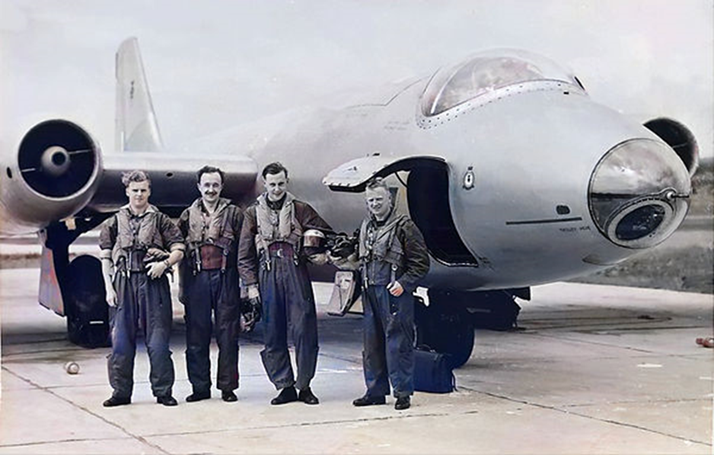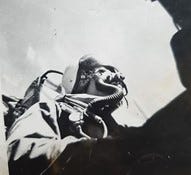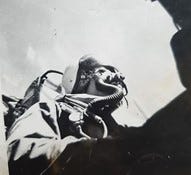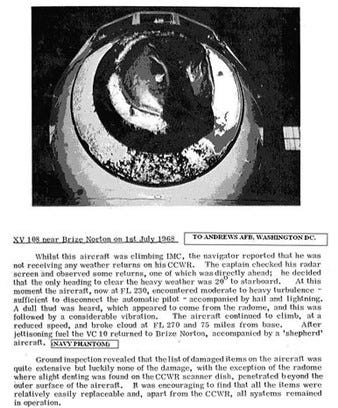Memories of a Cold Warrior
Up at the sharp end of global conflict in the 1950's and 60's
Technology moves on with inexorable speed and nowhere more so than in flight and warfare. As some will know my dad, always known as Taff, was a pilot in the RAF during the period when the Cold War threatened to warm up.
When he was very old a few years ago, (but very compos mentis) I sat down with him to talk through his flying days. He was extremely accurate on places, dates and times and the facts that I could verify through his logbooks and newspaper reports always checked out.
He died not too long after these conversations and I’m struck by how incredibly …well ‘quaint’ is the wrong word, but how his flying days feel most definitely like they have now long gone, never to return.
He flew in the RAF from 1952 to 1974 then in civilian aircraft for a further twelve years. He flew the English Electric Canberra during the Suez crisis and then moved to Vulcans from 58 to 64 - the height of the Cold War. After that he flew Comets and the VC10.
The minutiae of being an operational pilot, chosen for what would have certainly been a suicide mission in the early 60’s, still fascinates me and brings me up short. Anyway I’ve stitched together some of his conversations from the notes I took….. I’ve left out most of the technical stuff which he would include for me. It was a compliment, but most of the time I didn’t know what the hell he was talking about!
But here’s the other stuff. Hope it’s of interest. Don’t be put off by the slightly techy beginning - it’s necessary
Gareth: So, listen, I’ve been wondering about the Canberra, I know the Vulcan was very maneuverable, was the Canberra too?
Taff: Oh yes it was a very good aircraft, but it could bite you. It had a problem with its gravity feed fuel pumps, which could starve the engines. I remember Jack (Jack Tallis – Dad’s Navigator throughout his time on the 3-man Canberra) and I were acting as targets for fighters to practice attack runs. Sometimes we were allowed to take evasive action. One time we were over the North Sea to the north of the Thames estuary, we watched a fighter closing in behind us and then I really pulled as hard a turn as I could. The pumps couldn’t manage the 'g' force and both engines flamed out! (Basically, they died).
Gareth: What did you do?
Taff: Well, it all went very quiet, which was extremely disconcerting! We were quite high about 25 to 30,000 feet, and the Canberra had huge wings so it could glide well. I still had control of the surfaces (Flaps etc.) so we started to glide back towards Upwood (their home station in Cambridgeshire).
Gareth: Couldn’t you just restart the engines?
Taff: Yes, but I didn’t want to too early because the generators might only give you one chance and I wanted to be low enough to ensure there was plenty of oxygen for that start. So, I waited as the plane lost plenty of height.
Gareth: How low did you let it go?
Taff: I don’t remember. It would have been under 10 thousand…. Jack had identified a couple of alternate airfields for us to attempt to reach, but when I hit the start buttons the engines sparked up no problem……
Gareth: That must have been a big moment!
Taff: Yes, but Jack would have got me into somewhere even if they hadn’t. Forced landings used to happen quite a lot then. The key thing was not to do them in the North Sea!
Side note: Post-war aircrew were taken into the North sea on a launch and thrown into the sea with a life raft. They would then be left to get on with it for several hours before being rescued. It was something Dad hated with a passion!

(The UK in a classic case of imperial overreach, decided to invade the Suez canal area after Col Nasser of Egypt nationalised it. America swiftly put a stop to things.)
Gareth: Do you remember much about Suez? It was the only time you ever actually got shot at I guess.
Taff: Oh yes, but that was mainly because the powers that be decided we should fly straight and level at 25,000 feet for the bomb run, which made us a nice target. I could see the anti-aircraft fire puffs of smoke around us, most were pretty inaccurate though. At first it was strange to even see the smoke and identify it as anti-aircraft explosions.
Gareth: So how many sorties did you do?
Taff: Three I think. (His logbook shows the three in early November ’56)
Gareth: Anyway, you moved to Vulcans not long after that didn’t you. What did you think about carrying Yellow Sun? (This was a high yield nuclear weapon. It had a flat front. Black RAF humour called it “The bucket of sunshine”)
Taff: In what way?
Gareth: Well - could you actually have dropped it?
Taff: I could, yes. I had thought about it quite a lot when I got transferred to the Vulcan. In Suez one bloke on our squadron pulled up the landing gear on the runway as a protest before the first mission. I thought that was ridiculous. What did he think the deal was… he could pick and choose when to do as he was ordered?
Anyway, on the Vulcan there was more at stake…..I decided that I would definitely drop the bomb if the UK had been attacked. I might have had some hesitation if we had attacked first, but the whole idea was that the Russians knew that if they invaded West Germany using conventional weapons we wouldn’t have been able to hold them. We would have pulled the trigger at that point. It made it a no-win game for everybody. It worked too.
At Waddington the thing was that even if we had managed to get the planes off the ground, we would have had nothing left to come back to anyway. So, that made up my mind.
Subsequently Dad was proved to be spot on in his assessment in terms of damage in the UK at least. After the Cold War ended millions of classified Soviet documents were released, including one listing UK targets for Soviet missiles. Near the top of the list with two missiles aimed at the runway, was RAF Waddington, our station. Our married quarters were less than a mile away from the planned impact point.
Gareth: Were you very worried during the Cuban missile crisis?
Taff: No, not really and now I'm not quite sure why! We got down to 5 minutes readiness at one point, which meant we were in the aircraft ready to go….. I was much more worried personally when Kennedy was assassinated. I thought he was a really good, strong, steadying force. There was a period of time when there was a suggestion the Russians may have done it. I seem to recall spending some extra time on QRA then and worrying that Mum wouldn’t know what was happening.
(QRA or Quick Reaction Alert was the plan to get as many aircraft as possible into the air before any surprise Russian attack hit the UK. This meant within the 4-minute window before launched missiles landed on British soil. It involved pilots sitting in caravans next to their planes, or in them in times of great tension).
Gareth: So anyway, what’s this thing I’ve read about eye patches for Vulcan pilots?
Taff: Yes, my co-pilot and I had an eye patch each. We’d fly on instruments most of the way there, with anti-flash curtains pulled down on all of the windows. As we neared the point of bomb release one of us would pull up their curtain to be able see out ahead. It was thought though that there would be nuclear explosions all around us and any of the flashes from those would permanently blind us, so we wore an eye patch. When we were blind in one eye, we’d swap the patch over to the blind eye. When we had seen two explosions we’d pass command to the other pilot, who’d do the same. It meant we had four chances to deliver the bomb.
Gareth: Jeeesus!…..
Taff: (Smiling) Well yes. You see, we weren’t mucking about….
Gareth: Yes…..So, tell me something else. I looked up the Vulcan range recently and it was about 2,500 miles. Moscow …
Taff: Mine was one of the better rated crews so our target was always Moscow. I was never targeted anywhere else.
Gareth: …. right, but Moscow is 1,500 miles from Waddington.
Taff: Yes
Gareth: So, doing the sums, you could get there, but you couldn’t get back!
Taff: Well yes that’s true, but don’t forget that we would have had nothing left to come back to.
Gareth: So, what were your instructions after you’d dropped your bomb?
Taff: We didn’t have any! We could make it up. It wasn’t something we talked about…My plan was to head south putting on as much height as I could. If we were lucky, we might reach the Med or Turkey.
Gareth: Crikey. (Pause)
Gareth: So why did you get sent to Borneo in ’64?
The UK was involved in a “Police Action” against rebels in Northern Borneo. It involved extensive operations by Ghurkhas and SAS, supported by RAF helicopters and transports.
Taff: They needed a pilot on the ground to run the air support operations and I was just finishing my second Vulcan tour.
Gareth: So, they spent millions training you to fly bombers and then stuck you in the jungle directing Whirlwind helicopters!
Taff: Yes. Never make the mistake of thinking the RAF was entirely logical!
Gareth: You got a cancerous ulcer on your face quite early on…...
Taff: Yes, Mum wasn’t impressed at all. I was "medevacked" out. I was supposed to be there for a year, but only ended up doing 5 months, then back to Comets at Lyneham and then ‘10s at Brize (Vickers VC10 at RAF Brize Norton)
Gareth: Must have been odd flying a civilian airliner after those bombers?
Taff: Yes, but the ‘10 in RAF spec was a lovely aircraft. It had a standard body but the uprated engines from the larger Super VC10. We used to do climbs out of foreign airfields that were not far off the Vulcan’s. But only when there was no one down the back!
Gareth: Yes, that might have been a bit of a surprising take off for passengers. Do you remember when you flew through a thunderstorm in a VC10 that knocked the front of the nose off?
Taff: Yes, I do. it was a shame but we just couldn’t get out of the way. Big bang and the Radome on the front stoved in. We lost most of the instruments and we had to get a fighter up to escort us back to Brize calling out airspeed and so forth.
(A report on this incident is below. It’s terrible quality, but shows the damage to the front of the VC10)
Gareth: I’m always interested about your only accident, if that’s the right thing to call it, right at the end of your career when you were flying exec jets for Shell out of Heathrow. Your HS125 even made the papers!
Taff: Yes, it was just a bit of fun really. We’d taken off from Heathrow for Amsterdam but when we got there the port landing wheel wouldn’t descend. We did all of the usual tricks to try and shake it down. I even bounced the plane off its good wheel on the runway to shake it loose. Finally, I decided that if I had to do something potentially hairy I’d rather do it back at Heathrow, so I set off back. It also burned off some more fuel. When we had stooged around for a bit, and were almost empty, Heathrow decided we’d use a taxiway to land, rather than the runway, to avoid disrupting the airport. I didn’t mind. So, I landed the plane very gently and kept the wing off the ground for as long as possible. Eventually it hit, but didn’t do much damage.
Gareth: The plane looks a bit sorry for itself in the pictures. Did they give you a gong (a medal in RAF slang) or anything?
Taff: No. I got a nice letter from the Chairman of Shell instead, but that was OK. It was what I was there for. The plane was OK, it was scraped, but nothing too bad. …….
I’ve extracted this article from a website I put together for my Dad after he died. It has more tales from his unusual life it’s at www.taffwilliams.com. It tells how a farm labourer from South Wales ended up piloting the most sophisticated aircraft of the mid-20th Century






